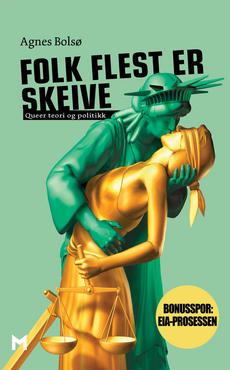Neoliberalism at play: An interview with Margot D. Weiss
Sunday, September 12th, 2010– by Mika Nielsen and Tove Nilsson

At the conference Desiring Just Economies /Just Economies of Desire that took place in Berlin this summer, we hurried to get good seats for the presentation of the paper “Unpacking the Toy Bag: Commodity and Power Exchange in BDSM Communities.” Author of the paper was Margot D. Weiss, Assistant Professor of American studies and Anthropology at Wesleyan University, USA.
Weiss’ research focuses on sexual cultures and politics in USA today. Focusing on BDSM, she explores how certain subjects and performativities are made possible and others impossible in the BDSM communities; examining how intersections between consumer capitalism, neoliberalism, race, gender and class affect sex practice. She relates BDSM sexuality to socioeconomic facts, and has, for instance, questioned the transgressive potential of the dungeon.
After Weiss’ presentation we interviewed her about the status of BDSM research in the US, the constructed dichotomy between feminism and BDSM, and her forthcoming book, Techniques of Pleasure: Subjectivity and the Socioeconomics of BDSM (Duke University Press).
In your book Techniques of pleasure: Subjectivity and the Socioeconomics of BDSM, intersections between consumer capitalism, neoliberal rationalities, and racialized,
gendered and classed social hierarchies are crucial. How do you see these structures affect your material?
My book is an ethnography of the “new guard” pansexual BDSM scene in the San Francisco Bay Area. Between 2000 and 2003, I did fieldwork in the Bay Area, combining participant observation at a wide variety of community events with 61 two- to four-hour interviews with diverse BDSM practitioners.
My book analyses this scene as a technique-orientated community, organized around SM educational organizations, classes and workshops, semipublic dungeons, and other community events. Many of these new practitioners are in their forties and fifties, and they are as likely to live in the suburbs as in the city of San Francisco. Most are involved in long-term relationships, either married or partnered; the men are majority heterosexual, while the women are bisexual and heterosexual. And the vast majority of practitioners are white, with the means – or the aspiration – to buy the toys that, together with forms of self-improvement and technique, link community belonging with often invisible race and class privilege. For example, many of the practitioners I spoke with had spent between $1500 and $3000 on their toy collections, wardrobes and, in some cases, play spaces; such investments are a crucial way practitioners becomes skilled and knowledgeable members of the BDSM community.
It is somewhat ironic, then, that for many practitioners as well as social theorists, SM practice is imagined to transgress social relations and social norms. Much of the pro-SM literature produced by practitioners and theorists argues that BDSM is “subversive.” Working from Michel Foucault’s glorification of San Francisco’s SM “laboratories of sexual experimentation,” scholars have imaged SM as a break with both subjectivity and capitalist productivity. This fantasy participates in a logic that cordons off sexuality from the social real, creating the deep irony of a community organized around rules, regulations, codes of conduct and techniques, but one whose members also and simultaneously desire SM sex to be “free” of precisely these regulating norms.

Michel Foucault
Departing from this Foucault-inspired analysis of the radical alterity of BDSM practice, I show, instead, the way BDSM sexuality – indeed all sexuality – is a social relation, linking subjects (private desire, identity, autonomy, fantasy, embodiments) to socioeconomics (public community, social hierarchies, collectivity, social power). I call this linkage a circuit in order to emphasize the productivity of the exchanges between realms imagined as subjective or private and those understood as social or economic. In chapters on BDSM rules and classes, toys and other commodity exchanges, gender play and “cultural trauma play” (play with race and ethnicity), I show the ways SM community, practitioners, practices, and scenes are linked in complex ways to the social and historical formations of race and gender in the United States, but also to the subject positions produced within late capitalism.
One crucial aspect of this is neoliberalism – a cultural formation or a political rationality that produces and validates subjects with particularly marketized understandings of the relationship between the public and the private. In SM, this emphasis on free choice, individual agency and personal responsibility can justify – by obscuring – the forms of social inequality performatively produced and reproduced through community, a disavowal installed in SM through alibis such as color-, gender- or class-neutrality. For example, practitioners believe that SM roles are “freely chosen” in accordance with liberal ideas of choice and agency; SM roles, in this analysis, have nothing to do with forms of social inequality. However, when, for example, practitioners claim that a charity slave auction is unrelated to historical slavery, SM participates in a kind of neoliberal whiteness that disavows social and structural racism through a colorblind, individualist approach to privilege. This logic can create opportunities to “transgress” – or at least feel free of – oppressive social norms while simultaneously restricting these possibilities to – and bolstering the position of – those with class, race and gender privilege.
In this way, the book shows that SM performance is material: rather than a safe or separate place of “play” (a radical alternative or outside to everyday life), SM community is, instead, deeply tied to capitalist cultural formations; rather than allowing for a kind of freedom from race, gender and sexuality, such SM practice and performance both remakes and consolidates the social norms that produce subjectivity, community and political imagination.

Is there anything you would like to evolve concerning gender issues in particular, how they play a part and what affect they have in your dissertation?
My work is crucially concerned with gender and gender play. One of my chapters, entitled “Beyond Vanilla: Public Politics and Private Selves,” is an analysis of gender play that parallels social inequality: male dominant/female submissive couplings. Departing from both radical anti-SM feminist theory and Foucault-inspired queer theory, I argue that SM neither reproduces social relations (as a faithful copy) nor transgresses them (as a resistant form of play acting). Instead, I explore the ambivalence generated through the mimetic relationships between gendered, raced and sexualized social norms and SM roles, between the social real and the SM scene/play, within the context of neoliberal understandings of choice, freedom and agency. I analyze the ways the desire to transgress social norms produces a split between the public (of oppressive social norms: white privilege, heteronormativity and sexism) and the private (of personal desire). Such splits rely on a narrative of self-empowerment, where the “freedom” to sidestep or remake oppressive social norms relies on precisely the forms of social privilege instantiated through such norms. The ambivalence I track in this chapter is one way of thinking this split: an uncanny disavowal that names the ways practitioners know and do not know, name and fail to name, the social relations of power – grounded in material relations – that drive SM play.
In 2005 there was an anthology published in Sweden on Swedish queer research.
In 2005 the anthology Queersverige was published with a focus on Swedish queer research. In the preface Don Kulick pointed out that when sex radical researchers like Gayle Rubin are presented in Swedish research, they are not presented with focus on their ideas on sexual practices. Instead these ideas are marginalized. Kulick sees this as a symbol for queer in Sweden being reduced to just issues of sexual orientation (meaning homo/bi/hetero) and gender. Can you see parallells to this in the gender/queer research in USA?
I think, in general, that something similar happens in the US, although it is important to differentiate between work on “queer” (meaning gay, lesbian, bisexual, occasionally trans) topics, which often re-solidifies identitarian categories, and work in queer theory or queer studies, which, in general, pays much more attention to the production and enforcement of those categories. More recent queer studies work on the relationships between sexuality and capitalism, racialization, disability, globalization, etc. has broadened the range of queer studies, and given scholars new tools with which to think through sexuality in terms of social theory. I’m thinking of the issue of Social Text, “What’s Queer about Queer Studies Now…”, and work by Kevin Floyd, Martin Manalansan, Robert McRuer, Lisa Duggan, Tom Boellstorff, among others. At the same time, there remains less work on sexual practice, per se – a situation I hope is changing.
In Sweden there is only one ongoing work in the field on graduate/post-graduate level, which is Kim Herburt who writes about the history of sadomasochism in Sweden. Can you describe the BDSM research in the US? How many researchers are working in the field? What are the themes and focuses within this research at the moment?
I wouldn’t really describe BDSM research in the US as a field: right now, there are a few researchers scattered across different disciplines. You can see this in the three relatively new edited volumes on SM: Darren Langdridge’s and Meg Barker’s Safe, Sane and Consensual: Contemporary Perspectives on Sadomasochism (2007); Thomas S. Weinberg’s S&M: Studies in Dominance & Submission (1995); and Charles Moser’s and Peggy J. Kleinplatz’s Sadomasochism: Powerful Pleasures (2006).

Because I am interested in linking BDSM (and sexuality in general) to broader socioeconomic formations, I am mostly interested in ethnographic or cultural approaches to sexuality. The only other US-based anthropologist I know who has published ethnographic work on BDSM is Gayle Rubin; there is a graduate student named Richard Martin whose work on BDSM in Germany I look forward to reading. I’ve also found work by Jacob Hale, Patricia Duncan, and Robin Bauer useful in my work and my teaching.
In the literature as a whole, BDSM is most often approached as either an abstract problematic or an individualized orientation. The former – work in philosophy, cultural theory, feminist theory and literary criticism – is useful to theorize SM dynamics or explore the political or ethical dilemmas posed by SM, but I often find it too abstract to account for historical (or socioeconomic) particularity. The latter – work in social psychology, psychoanalysis, and sexology – is effective in dispelling some of the more pernicious stereotypes of SM practitioners, but I’ve found that it tends toward either statistical approaches or individuating desire, whereas I prefer a more social, community analysis.
There is also, as I’m sure you know, a large collection of non-academic journalistic, political, essayist and practitioner-oriented guides, how-to’s and anthologies on BDSM.
At the conference in Berlin you mentioned that one of your chapters deals with feminist resistance against kinky issues. Can you tell us more about that?
Sure. The chapter, as I mentioned briefly above, focuses on “het male doms” – white men who identify as heterosexual dominants. The chapter analyses these men’s anxiety about not being “transgressive” enough. I show that this anxiety stems from the desire for SM sex to stand outside, as a-productive of, social relations – to be “safe” and “separate” from real life gender roles. Exploring the imagined connections between “real world” social norms and the “safe” world of “the scene,” I contrast the two most common analyses of SM play: the radical feminist anti-SM position and the queer pro-sex/SM position. In the radical feminist argument, this seeming replication means that SM roles and play scenes are exactly the same as the social relations of inequality (patriarchy, primarily) that give them form, whereas in the queer argument, SM scenes flout these (hetero)normative conventions, and thus transgress or subvert social norms. This debate, stated baldly, is the SM version of the familiar replication/reenactment versus subversion/transgression binary.
Yet the ambivalence voiced by these men suggests another reading, in which the desire to be transgressive relies on the construction of a boundary between the “real world” (of capitalism, exploitation, unequal social relations, and social norms) and the “SM scene” (a pretend space of fantasy, performance, or game). Unpacking this boundary-making project, I show the ways gendered and raced performativity produces subjects who view their SM practice as private and individual, as a form of self-cultivation and mastery. However, this sense of personal autonomy, agency, and choice also relies on liberal (sometimes inflected as libertarian and/or neoliberal) ideologies of agentic individualism and “freedom,” formulations that are complexly bound to both material and discursive formations. Thus, this fantasy of sex outside material relations, this desire to transgress social norms of racialized gender, produces a split between the public space of the law and the private space of desire that simultaneously creates opportunities (for “freedom”) and restricts those opportunities to those with privilege. The ambivalence of practitioners whose SM desires seem to match up with their social locations, then, illuminates a complex and contradictory social field, where the topography of social power, the justifications of social hierarchy, and the dense interconnections between gender, race, sexuality and class are produced, reproduced, and embodied.
In this way, the binary options for a cultural critic reading such scenes – subversive or reenacting? Political or personal? Feminist or queer? – fail to pay careful enough attention to what is being produced at such moments – a production that includes privilege and power, in addition to a non-normative self-cultivation and practice. Instead, I take seriously the radical feminist contention that sexuality, desire and fantasy are bound up in real-world structures of inequality, that we cannot separate the bedroom/private from the public/social world, while writing against the collapse of SM dynamics into the slavish reproduction of formal inequality.
In Sweden, there has been talk about a new kind of political kinky activism in the beginning of the 21st century. For example, bigger NGOs have integrated these issues in one way or another. At their 2007 congress RFSU, Swedish Association for Sexuality Education, decided to work with issues related to BDSM and fetishism. This year, RFSL, The Swedish Federation for Lesbian, Gay, Bisexual and Transgender Rights, took a similar decision. In general, a more public form of kinky activism is taking place. Can you tell us anything of the presence/absence of these issues in the social movement in the US?
I haven’t seen any of the big LGBT organizations in the US address BDSM or fetish communities. The main BDSM organization in the US is the NCSF (National Coalition for Sexual Freedom), a political and legal group that advocates for BDSM, leather, fetish, swing and polyamory communities. It is not, however, linked to LGBT groups or organizing as far as I know. In general, BDSM and fetish politics are not included in LGBT organizations, especially the mainstream (homonormative) ones, although there are local links and connections (for example, the San Francisco pansexual BDSM organization The Society of Janus participates in the annual Gay Pride, or the Leather Archives and Museum in Chicago has links to a variety of leatherman and leatherdyke clubs and materials).


What parallels are there between the research fields of gender and BDSM and what do you think can be gained in the gender research by including a kinky perspective and vice versa?
I think BDSM has much to teach us about the complex ways individuals negotiate social worlds. Gender – a primary axis of differentiation, of identity, of power, and of subjectivity – is densely linked to sexuality, race and racialization, class, nation, disability, and other calcified social hierarchies. BDSM is one – and I would say a particularly useful – way to think more complexly about how individuals situate themselves within and simultaneously reproduce larger social relations with greater and lesser degrees of control, since BDSM often spectacularizes these relations, thus rendering the contradictions already embedded in such systems even more apparent.
*

Tove Nilsson is an activist and Medicine Student at University of Gothenburg with the ambition to rip the system from inside.
Mika Nielsen is a PhD-student in Economic History. For the moment she is a guest PhD-student at Gender Studies at University of Gothenburg.



